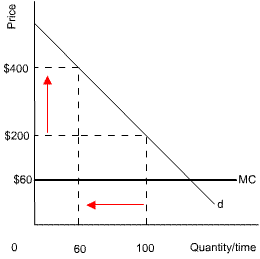Do you want BuboFlash to help you learning these things? Or do you want to add or correct something? Click here to log in or create user.
Subject 6. Price Discrimination
#cfa #cfa-level #economics #has-images #microeconomics #reading-16-the-firm-and-market-structures
Price discrimination is a practice whereby a seller charges different consumers different prices for the same product or service. It converts consumer surplus into economic profit.



Total costs are: $60 x 60 + $60 x 150 = $12,600.
Total profits are thus: $46,500 - $12,600 = $33,900.
- In first-degree price discrimination each consumer is charged the maximum he is willing to pay. Consumer surplus is nil, while producer surplus is maximized. The output is the same as in a competitive market.
- In second-degree price discrimination, prices vary across units but not people. Consumers self-select into consumption groups and seek the largest surplus.
- In third-degree price discrimination, consumers are segregated by demographic or other traits. Prices are determined by the demands of each group.
When sellers can segment their market (at a low cost) into groups with differing price elasticities of demand, price discrimination can increase profits. For each group, the seller will maximize profit by equating marginal cost and marginal revenue. The number of units sold also increases because the discounts provided to price-sensitive groups increase the quantity sold more than the higher prices charged the less price-sensitive groups reduce sales.
Imagine that the MC per unit for a monopoly is constant at $60, producing a horizontal MC curve, as shown below.

The firm produces where MC = MR. It thus produces 100 units and charges $200 per unit. Total revenue (price x quantity) for the firm is thus: $200 x 100 = $20,000. Total costs (cost per unit x quantity) are: $60 x 100 = $6,000. Total profit is thus: $20,000 - $6,000 = $14,000.
Imagine that this firm is an airline and that it now decides to increase its profits using price discrimination. It identifies two groups of people: businessmen, who are fairly price-inelastic, and students, who are fairly price-elastic (responsive to changes in price). By increasing the price of businessmen's tickets and decreasing the price of student's tickets, it can increase its total revenue and thus increase its profit.
The airline starts by doubling the price of businessmen's tickets to $400. By equating the businessmen's MR curve to the MC curve (for simplicity, the MR curve is not shown), the airline finds that the quantity demanded decreases, but by relatively little, given the large increase in price, to 60 tickets.

Next, it equates MC to the students' MR curve and finds that it can decrease the price of students' tickets from $200 to $150, whilst the quantity demanded increases to 150 tickets. (Note: for simplicity, the students' MR curve is not shown).

Therefore, the total revenue is as follows: $400 x 60 + $150 x 150 = $46,500.
Total costs are: $60 x 60 + $60 x 150 = $12,600.
Total profits are thus: $46,500 - $12,600 = $33,900.
This is more than the $14,000 profit the firm made in the absence of price discrimination.

If you want to change selection, open original toplevel document below and click on "Move attachment"
Summary
| status | not read | reprioritisations | ||
|---|---|---|---|---|
| last reprioritisation on | suggested re-reading day | |||
| started reading on | finished reading on |
Details
Discussion
Do you want to join discussion? Click here to log in or create user.